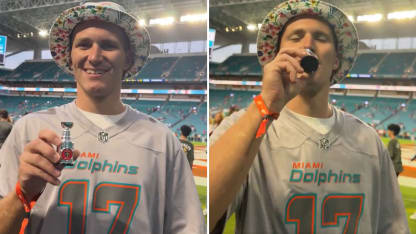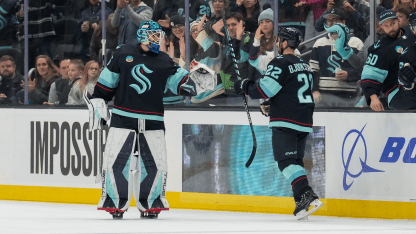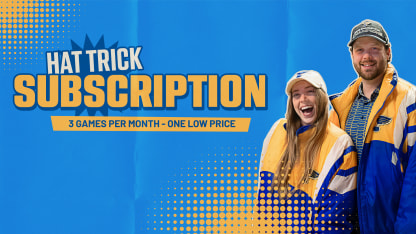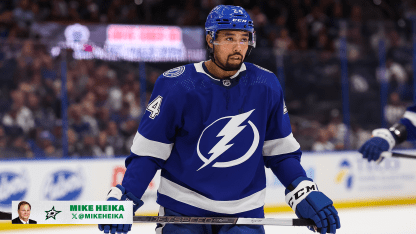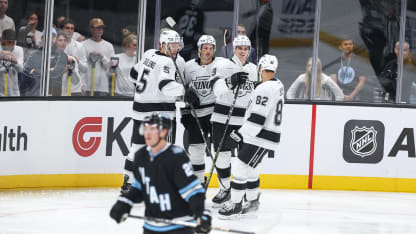TALKING POINTS: Bowman discusses Holloway & Broberg offer sheets
TALKING POINTS: Bowman discusses Holloway & Broberg offer sheets
Edmonton’s General Manager and Executive Vice President of Hockey Operations spoke to the media on Tuesday, addressing the team’s choice not to match the offer made by the Blues for the forward and defenceman.
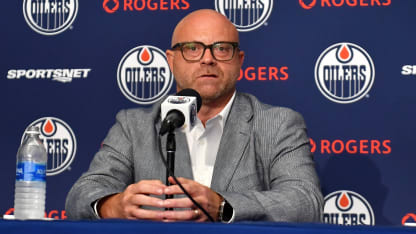
EDMONTON, AB – Oilers General Manager & Executive Vice President of Hockey Operations Stan Bowman held a virtual media availability on Tuesday to discuss the team’s decision to not match the offer sheets presented by the St. Louis Blues to restricted free agent forward Dylan Holloway and defenceman Philip Broberg.
Bowman’s opening comments:
Greetings to all. Thank you for sparing some time for this. I recognize that there are numerous questions, and I’m here to address them. It might be beneficial to begin with a review of our activities since last week when we received the offer sheets. This will provide a glimpse into the thought process behind our decision, after which I’ll be pleased to entertain any questions. So, upon receiving the offer sheets last week, we immediately convened as a team with the aim to thoroughly analyze our situation at that juncture and to consider every possible option. We didn’t dismiss anything at first glance. In our assessment, we identified basically four alternatives.
The first approach would involve matching both offer sheets. The second involves matching Broberg’s offer but not Holloway’s. The third tactic would be the opposite, matching Holloway’s offer but not Broberg’s. Finally, the fourth method would be to not match either offer. We dedicated significant time, several days in fact, evaluating these scenarios in the context of the immediate future for this year’s team, the near future including the trade deadline and off-season, and even further ahead. Our aim was to envision how our team would fare under each scenario, and we explored those outcomes. Ultimately, we made a decision based on the scenario that seemed most beneficial from our current standpoint.
I believe the team did an excellent job. We meticulously evaluated all our options, often leading us to further investigation. This prompted numerous phone calls with almost all league teams over the past week, trying to understand their roster intentions, whether they planned to move or add players. We left no stone unturned, but ultimately, we did not match either offer sheet, leading us to our current position.
In simpler terms, our decision was not a reflection on the players but a business move considering our short-term and long-term financial health. We had no concerns about our players. We decided not to match the offer sheets, knowing we’d get assets in return, leading to other transaction discussions. By managing this situation, we’ve achieved some goals, providing us with flexibility and options for the future, which we believe is crucial.
We didn’t limit ourselves to a single pathway for this season. Hence, we made further moves to incorporate a few young players along with additional draft picks and prospects. Looking at the whole picture, it’s clear that we were dealing with a challenging situation. However, I believe we made the best sequence of transactions, putting us in a favorable position for the upcoming training camp.
Stan addresses the media about the offer sheets from Holloway and Broberg.
On having an older team with some veteran free agent additions:
There are multiple ways to interpret this situation. Undoubtedly, looking at how things unfolded, it was encouraging to see that the Oilers are attractive to players who prioritize seeking a championship over other aspects. Each player is unique and at various stages of their careers. However, it was evident that players who opted for Edmonton, possibly sacrificing higher pay, did so because they saw potential in our team and wanted to be a part of it. This is indeed positive, and we hope it continues, aiming to make our team such a desirable destination. The key to achieving this in the coming years is to maintain a competitive team that appeals to players across the league, inspiring them to say, “I want to win, and that’s where I want to be.”
I wouldn’t state that our sole focus is on older players. Indeed, there is an advantage with them as they bring a wealth of experience from handling various situations, which is valuable. However, we have also integrated a few younger players into the organization, who already have NHL experience. These include Podkolzin and Ty Emberson, who are working hard to establish themselves as regular NHL players.
This is not a black-and-white situation. It’s definitely advantageous to include younger players in your team as they add a unique dynamic. They typically bring more energy and enthusiasm since they are new to the NHL or haven’t been here for a long time. We’re definitely open to having younger players on board. Likely, we’ll have a mix of both young and experienced players. The crucial factor for players like Podkolzkin and Emberson is their manageable salary cap hits. Given our team’s current and future situation, maintaining salary cap space and flexibility is crucial. Usually, young and veteran players have lower cap hits, while the contracts of mid-career players tend to be higher.
On the possibility of two younger players dictating the team’s salary cap position:
Returning to my initial remarks, we were assessing our situation when those offers came in. Given our current circumstances and other constraints, we felt it wasn’t the right decision to limit our options for the future. So, it’s not about the players’ skills and talents, but more about positioning ourselves optimally to have options. It’s August now, and there will be fluctuations in every team’s performance throughout the season, and we need to be able to adapt to that. The other options, either matching both or one of the offers, would have significantly impacted our salary cap this season and the upcoming ones. Thus, we made our decision based on these considerations.
On losing two defencemen from last season in Broberg and Cody Ceci:
Indeed, we do have it. We aim to establish a robust defensive approach before we hit the stretch run. At this stage, we have numerous alternatives and players we are hopeful will step in and fulfill a role for us. It’s true, our team combination is not the same as it was a few months ago in Game 7. One of the actions we are taking is to provide them an opportunity to prove themselves, and we have added some new defencemen.
Stecher isn’t new, but he didn’t have many chances to play late last season. Additionally, we have Brown and Emberson. We need to provide these three players an opportunity to prove their worth. We’re optimistic that they can step up and fill larger roles, given that our team is quite different now. I’ve mentioned this before, but this situation might also allow us to save some cap space. If the need arises, we might be able to make an addition to our team in the future. This scenario presents such a possibility.
On the start of contract extension negotiations with Leon Draisaitl:
I anticipated that question, which is quite understandable given the high interest in Leon. To that end, I can confirm that we have initiated discussions with Leon and his representative. However, I prefer not to delve into more details. Over the years, I’ve found it best to keep such matters between the agent and us. This should not be interpreted negatively in any way. I don’t wish to impose any timelines or expectations. The process has started and when there’s an update, we will surely inform everyone.
On the injury status of Evander Kane heading into the season:
I need to clear up some misconceptions, notably around the functioning of player injuries, the long-term effects, and the impact on their cap hit. Here’s a simplified explanation: In cases like Evander’s injury, the next steps are determined by Evander and his medical team, not me. I don’t have, nor should I have, any influence in this. My main role here is to support Evander and ensure his recovery.
In case of an injury, there are several potential options. These include undergoing treatment, rehabilitation, and ultimately, the player can recover and resume play. Some injuries immediately necessitate surgery as the only viable solution. However, there exists a third category of injuries where the course of action isn’t clear-cut. In such scenarios, the player can choose from several alternatives, and it’s their call to make. We plan to fully support Evander in this situation. Presently, we are dealing with this third type of scenario. We are uncertain whether this will result in him missing a small portion of the season or, if surgery is required, a larger part. We lack this information at the moment. I don’t have a say in this, and it’s a matter he will discuss and decide upon with his physicians.
I believe it’s pertinent to this discussion to dispel the notion that a player’s injury automatically means they are relegated to long-term injury status, thereby eliminating the need for trades or any concerns. This is not entirely true, as you still need to factor in that player’s salary cap. The player might either be off LTI and included in your regular team cap, or if the injury exceeds 24 days and 10 games, they could be put on long-term injury status. However, you must be prepared to activate him once he recovers from the injury. This was a frequent topic in our discussions; a player may start the season on long-term injury status if he is expected to be out for at least a month. Yet, it’s crucial to have a strategy for when he is fit and ready to play, which posed a more significant challenge.
I’d like to point out that with long-term injuries, no cap space is accumulated. If you utilize long-term injury for several months and then reactivate the player, you start from scratch with no cap space, trying to build it up. Hence, in a month or so, you won’t be able to accumulate much. All these factors influenced our decision. Currently, we’re positioned to begin the season without any injury-related issues for Evander Kane. He’ll be in the same state as everyone else. If he’s ready to play immediately, that’s excellent. If not, we’ll manage to make room for him once he’s fit.
On the additions of Vasily Podkolzin, Ty Emberson and Paul Fischer:
I can provide some background about all three of these players. In situations like we had last week, we usually consult with our entire staff and anyone who may have a connection with the players being discussed in my conversations with other teams. Specifically for Emberson, I spoke with Kris (Knoblauch), who is quite familiar with Ty and spoke highly of his game. He appreciated having him on his team in Hartford and found him to be a very effective player. It’s always beneficial when there’s a comfort level between a coach and a new player, although this doesn’t happen often when the coach has worked with them externally. So, this was a helpful factor in our decision.
Podkolzin was a top draft pick, taken 10th overall, and had a promising start to his NHL career. However, since then, he has spent most of his time in the American League and his performance has changed with the shifting regime. This is not an unusual phenomenon, as many players experience changes in their performance due to various reasons. This is not to disparage anyone, as often the situation or the player are not to blame.
Nevertheless, I am impressed by Podkolzin’s skill set. He has the ability to score, has a powerful shot and is a physically strong player. His style is direct and physical, and he is not afraid to engage in possession play in the offensive zone or to tackle opponents when not in possession of the puck.
This combination of skills is impressive and I believe we can help him regain his earlier form, not just from his draft year but also from his first professional year. It will be up to our coaches and team to bring out the best in him. Sometimes, a fresh start can be beneficial for players like him.
I’ve known Paul Fischer for a long time, he’s a Chicago native and I’ve watched him grow from a young boy playing countless games throughout the years. His journey to the U.S. national team was impressive, even though an injury during his draft year may have affected his draft position. I observed him last year at Notre Dame where he excelled as a freshman defenseman and played a significant role on the team. He’s also a contender for the U.S. World Junior team. Paul is a likable player with a good combination of size and skill. Despite being young and having areas to improve, he’s a highly motivated individual with strong character traits. I also know him well personally and I’m confident he will do everything he can to improve. It’s encouraging as we work on building our team and focusing on player development. We’re dedicated to finding young prospects like Paul and helping them fast-track their growth and development to reach the NHL sooner.
On Bowman’s initial reaction to receiving two offer sheets from the same team:
Undoubtedly, it was a challenging situation. Offer sheets are not common, let alone receiving two simultaneously. My response was to dive in and tackle the task at hand. Once the offer sheets were submitted, I can see why fans or the media might focus on various aspects, but my attention was squarely on the future. Now, we have a decision to make. We’re faced with a challenge and need to piece together a solution. It was indeed a tough task to determine the best course of action. However, assessing the entire situation, I’m confident about having navigated it optimally and created some viable options for the future.
On whether he harbours any negativity towards the Blues after the offer sheets:
I believe it’s crucial to keep business and personal matters separate. Doug Armstrong and I share a long history, having had numerous clashes when I was in Chicago and he remained in St. Louis. However, I don’t perceive it from a personal perspective. I acknowledge that every manager may potentially use this tactic, and it’s our responsibility to respond appropriately and act in our best interest. Personal emotions cannot interfere with such issues. We must maintain a professional relationship with all the league’s managers, and I plan to continue doing so.
On the possibility of targeting any more players between now and the start of the season:
At present, I believe all options remain open. I don’t think it’s beneficial for us to shut any doors currently. Perhaps it would have been clearer if I’d stated earlier that we have fresh talent that we need to provide opportunities to. They joined our team for a reason, and in the case of Emberson, we traded for him. We aim to provide them an opportunity to prove their worth and potentially become a valuable asset to our team. Part of my role involves considering all possibilities, whether through further trades or free-agent players available in the market. I plan on doing that, but whether it will yield anything is uncertain. We still face certain limitations, particularly with our salary cap, which isn’t changing, so we’ve been cautious to maintain some flexibility for the future. So, the short answer is yes, we do have the capacity to engage with players and see if anyone is worthwhile to recruit.

